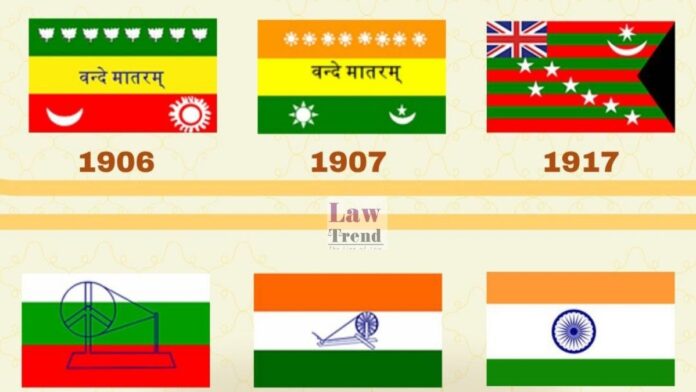The Indian Tricolour, or Tiranga, as it stands today, is a powerful symbol of a sovereign nation. However, its design is the culmination of a long and significant journey, mirroring the decades of India’s freedom struggle. The flag evolved through six distinct phases from 1906 to 1947, with each version encapsulating the political and social ethos of its era. The final form was officially adopted by the Constituent Assembly on July 22, 1947, just weeks before India’s independence. This is the story of its transformation.
1. The 1906 Flag: A Symbol of Unity and Protest
The first unofficial flag of India is believed to have been hoisted on August 7, 1906, at the Parsee Bagan Square (now Girish Park) in Calcutta. It was a direct response to the Partition of Bengal, intended as a symbol of national unity.
Design: The flag consisted of three horizontal stripes of equal width: green on top, yellow in the middle, and red at the bottom.
Symbolism: The top green stripe featured eight white lotuses, representing the eight provinces of British India. The central yellow stripe bore the words ‘वन्दे मातरम्’ (Vande Mataram) in Devanagari script. The bottom red stripe displayed a crescent moon on the left and a radiant sun on the right.
2. The 1907 Flag: The First Unfurling on Foreign Soil
A slightly modified version of the 1906 flag was raised by Madam Bhikaji Cama in 1907 in Stuttgart, Germany, during the second International Socialist Congress. This marked the first instance of an Indian flag being unfurled on foreign land.
Design: The colour scheme was altered to saffron on top, followed by yellow and green.
Symbolism: The eight lotuses were replaced by seven stars, representing the Saptarishi—the seven great sages revered in Indian tradition, symbolizing guidance. The ‘वन्दे मातरम्’ inscription remained on the central yellow band. The bottom green stripe featured a sun and a crescent moon with a star.
3. The 1917 Flag: The Home Rule Movement
During the Home Rule movement, led by Dr. Annie Besant and Lokmanya Tilak, a new flag was adopted as a symbol of the demand for self-government within the British Empire.
Design: This flag was markedly different. It featured five red and four green alternating horizontal stripes. In the top-left corner (the canton), it retained the Union Jack. Seven white stars arranged in the Saptarishi formation were superimposed on the stripes. A white crescent and a star were placed in the top-right corner (the fly end).
Symbolism: The inclusion of the Union Jack signified the movement’s initial goal of dominion status, while the other elements asserted a distinct Indian identity.
4. The 1921 Flag: The Arrival of the Charkha
Mahatma Gandhi, recognizing the need for a unifying national symbol, commissioned a new design. At the All India Congress Committee session in Bezwada (now Vijayawada) in 1921, a flag designed by Pingali Venkayya was presented.
Design: This flag was composed of two horizontal stripes, red and green, representing the two major religious communities, Hindus and Muslims. Gandhi later suggested the addition of a white stripe on top to represent all other communities and a blue Charkha (spinning wheel) across all bands to symbolize progress and the self-reliance of the Indian people.
Symbolism: This was the first design to explicitly incorporate the Charkha, which would become a central emblem of the freedom movement, representing economic empowerment and Swadeshi.
5. The 1931 Flag: The ‘Swaraj’ Flag
A landmark resolution was passed in 1931 adopting a new tricolour as the official flag of the Indian National Congress. This design laid the direct foundation for the current national flag.
Design: The flag featured three horizontal stripes: saffron on top, white in the middle, and green at the bottom. A blue Charkha was placed in the center of the white band.
Symbolism: The religious interpretation of the colours was officially abandoned. Instead, the colours were given new, secular meanings: saffron for courage and sacrifice, white for truth and peace, and green for faith and chivalry. This flag, widely known as the Swaraj Flag, was used extensively during the final years of the independence struggle.
6. The 1947 Flag: The Tricolour of Independent India
As India approached independence, the Constituent Assembly established an ad hoc committee headed by Dr. Rajendra Prasad to finalize the national flag. The committee decided to retain the 1931 design with one significant modification.
Design: The saffron, white, and green stripes remained unchanged. The Charkha in the center was replaced by the Ashoka Chakra (Wheel of Dharma) in navy blue. The Chakra is a depiction from the abacus of the Lion Capital of Ashoka at Sarnath.
Symbolism: The colours were formally defined: Saffron signifies strength and courage, white indicates peace and truth, and green represents the fertility, growth, and auspiciousness of the land. The Ashoka Chakra, with its 24 spokes, represents the eternal wheel of law and the nation’s continuous movement towards progress.
This final version of the Tiranga was adopted on July 22, 1947, and presented to the nation. It stands today as a testament to the country’s historic struggle, its philosophical foundations, and its aspirations for the future.
Byline: Dr. Rajat Rajan Singh, Advocate




